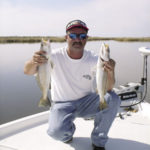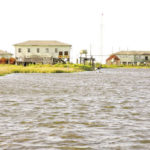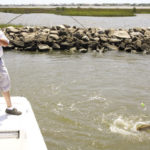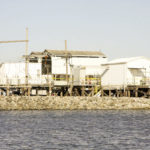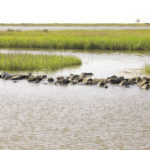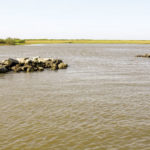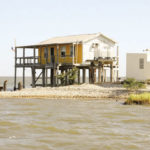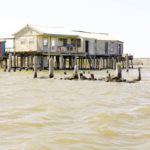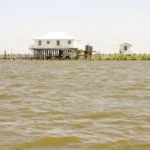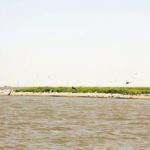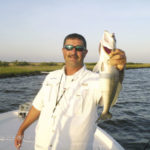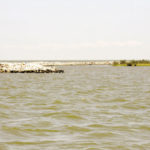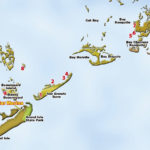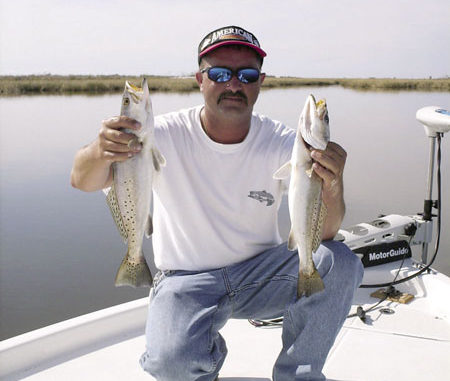
Grand Isle’s neighbor to the east has everything a June angler could possibly want.
Capt. Eddie Berthelot and I idled into the Wildlife and Fisheries Canal on the north side of Grand Terre Island in late April with prior knowledge and past years’ experiences pointing out that we were about to have a good time. The charter captain who is also a fire captain with the Houma Fire Department began casting a live cocaho under a popping cork, and I a glow/chartreuse Bayou Chub soft plastic. Our first casts were to the middle of the canal to check if the speckled trout were there.
They weren’t, so we focused on fishing the cuts and chutes in the surrounding marsh with the same baits. However, I switched over to a tightlined Bayou Chub in case I saw any redfish cruising the points and pockets.
The first two we saw pushing fell for my Bayou Chub presented right on their noses. After slinging a couple more into Berthelot’s Blue Wave bay boat, I concurred with him that this canal was a good spot, but I wanted to go look for some trout.
“Trout may be hard to come by today,” Berthelot said as we idled north out of the canal. “The water’s still too cool down here, and I’ll be happy if we pick up five or six trout. As good as the backside of Grand Terre will be in June, it’s that bad right now except for the redfish.”
We started bouncing from spot to spot to check just about every hole that Berthelot knew. Each one gave us a sampling of redfish, but none yielded any speckled trout. Had we run up into Barataria Bay, we might have found some specks, but our trip was to explore the waters around Grand Terre.
“Look at the hotels and camps for rent on your way out this afternoon,” Berthelot instructed. “You’ll see a lot of empty rooms. But come back in June and see how many of them are empty. You won’t be able to find a room.”
Our exploration took us from the Wildlife and Fisheries Canal all the way over to some camps in Coup Abel and back toward Queen Bess Island and Panama Point. All were an easy run from Sand Dollar Marina on the eastern tip of Grand Isle, and Berthelot assured all would be chock full of speckled trout and redfish this month.
Of the spots we looked at, these were the 10 that Berthelot said would be best.
• No. 1: Wildlife and Fisheries Canal
N29 16.61 x W89 56.53
The very first spot anglers should check as they get to the west side of Grand Terre is the Wildlife and Fisheries Canal. This spot is easy to find because of the old, green research buildings at the back end of the canal. A marked entrance to the canal is lined with rock jetties on both sides.
“This is the kind of spot you can anchor down and catch a limit of trout in a couple hours,” Berthelot said. “I like to keep moving around with the trolling motor until I find some fish, then sit on top of them with the anchor down.”
Fish live bait under a cork for the trout. However, plastics work well, too, if the fish are really biting. Try darker colors if the water is murky and lighter colors like clear, glow, pink and green if the water is clean.
“All the marsh to the east of this canal holds redfish,” Berthelot said. “Troll around in there, and cast live bait or plastics under a cork, or you can sightfish for pushing reds with just a plastic on a jighead.”
• No. 2: Pump Station
N29 17.22 x W89 55.72
This spot is the western end of the rock protection levee that lines much of the backside of Grand Terre. The rocks end in a sharp corner just behind the pump station, and this entire area acts as a bait magnet, which makes it a fish magnet, too.
“The rocks go about a mile and half, and you can fish all of them,” Berthelot said, “but there are a couple really good spots along the rocks, and this is one of them. Current moves parallel to the rocks when the tide is moving, and that piles the fish up in here.”
Berthelot likes to position his boat about 50 to 75 feet off the bank and cast live shrimp or croakers under a popping cork for bigger trout right up to the edge of the rocks. If there are a lot of birds working, or he’s on smaller trout, he’ll go with tightlined plastics.
“This is also a good spot to throw the Top Dog or Top Dog Jr.,” he added. “I like clear and chartreuse/white early in June, but I’ll swap to the green over white later on when the mullet start hanging around. This is an easy spot to duck in and check, so don’t run past without trying it.”
• No. 3: Protection Levee Cut
N29 17.525 x W89 55.053
A few tall posts dot the rock levee on the backside of Grand Terre, and Berthelot said this spot was on the third post as counted from the east side of the island. What makes this spot unique among the rest of the levee is a small cut coming out of the marsh and through the rocks.
“Bait hangs out on this flat in front of the cut,” he said. “It’s about 2 1/2 feet in front of the cut, and the lateral tidal current pushes a lot of bait past this cut. Couple that with the bait coming out of the marsh, and you’ve got a junction where two different groups of bait meet — no wonder trout like this spot.”
Like at No. 2, Berthelot likes to back off the rocks 50 to 75 feet, and cast toward the cut with live shrimp or croakers under a cork. But if the bite is really on, he’ll switch to Gulp shrimp or dark-colored H&H Cocahoes.
“You’ll mainly catch trout, but you could also catch redfish, flounder, sheepshead — whatever’s passing this cut. The rocks come out maybe 3 to 5 feet from what you can see, and the rest is a soft, mud bottom.”
• No. 4: East Side Cove
N29 17.698 x W89 54.696
The last of Berthelot’s spots on the rock levee, the very east side of the rocks, is where Grand Terre Island falls off into Four Bayou Pass. On the Grand Terre side of the pass is a small pocket that is formed by the end of the rocks, a slight turn in the island and a small island just north of the rocks.
“All the convection in this pocket from the current washing through the pass just sucks bait into this spot,” said Berthelot. “Add to that the couple of marsh cuts on this end of the rocks, and you’ve got another hotspot with so many fish, bait and shrimp coming from so many different directions.”
If you’ve got a smaller boat, Berthelot said you could get through the cut on this end of the rocks and troll around in the marsh behind the protection levee. However, if you’re in a big boat, your best bet will be to troll all throughout this pocket until you get on some fish, then stick your PowerPole or toss your anchor.
“With so much current in this pocket, I would recommend trying live bait on a short Carolina rig because the water is only a couple feet deep,” Berthelot said. “But you can also do well on the live bait under a cork all around this pocket.”
• No. 5: Coup Abel Camp 1
N29 19.955 x W89 50.480
The entire Coup Abel area is well known for being a great spot to catch bull reds, but Berthelot says there are some big trout to catch over here, too, and many of them can be found around some of the camps that still stand on the north side of this bay.
“You can fish all around this cove — all the camps and the opposite side against the shoreline,” said Berthelot, “but it might be easiest for anglers who aren’t familiar with the area to just target a couple of these camps. They’re easy to find, easy to fish and you can catch some good fish off of them.”
The first of the three camps that Berthelot pointed out is unique in that it is near a main pass that leads out into the Gulf of Mexico. That created a lot of current around the tip of the pilings to the west of the camp, and this attracts some big redfish.
“Throw some cracked crab on the bottom with a Carolina rig,” Berthelot suggested. “You can also catch reds on live bait or plastics under a cork.
“If you’re after trout around this camp, stick with the Tsunami swim baits or lead heads with dark-colored H&H Cocahoes.”
• No. 6: Coup Abel Camp 2
N29 20.024 x W89 50.397
Of the eight or nine camps to the north of Coup Abel, this one is unique in that it has its own little cove created by a curving line of rocks that used to line a piece of land. The land is now gone, but the rocks remain. On one side is a 2- to 3-foot flat and on the other a 10- to 12-foot pass.
“The rocks curve away from the camp and fall under water between 50 and 60 yards out from the camp,” said Berthelot. “These rocks are good for trout, but the reds hold on them, too. Depending on the wind and tide, pick a side and fish.”
For the trout, Berthelot likes live croakers and shrimp under corks. Birds can often be found working over shrimp on the shallow side of the rocks, and Berthelot fishes beneath them if they are present.
“The shallow side of the rocks gives you some protection, so that’s usually where you find the bait and trout,” Berthelot added. “But you can get on the deep side with some cracked crab on a Carolina rig and tear up some bull reds. Tightlined plastics will work on the reds, too.”
• No. 7: Coup Abel Camp 3
N29 20.553 x W89 50.360
Like the other two camps, this one has a unique quality that makes it better than some of the others. The “White Camp,” as Berthelot calls it, is totally surrounded by rocks and pilings. There is lots of structure in the water on which specks and reds can hold.
“This camp is good for medium to large speckled trout,” Berthelot said. “If I get to this camp early enough, I’ll drag out the Top Dogs for the surface or the MirrOdines to get down about a foot. Really, if there’s clear water and bait, I’ll try these two baits any time of the day.”
One of the more unique aspects of this island, other than it being surrounded by rocks and pilings, is that both are so closely clustered together that you don’t have to figure out which one to fish; you can fish both with one cast.
“If you want to pick up some bull reds, fish cracked crab on bottom with a Carolina rig or fish live bait under a cork,” Berthelot said. “And just remember that the trout are likely to be right on the structure, but they’re just as likely to be 50 to 60 yards away depending on bait activity.”
• No. 8: Queen Bess Island
N29 18.315 x W89 57.710
Locally known as “Bird Island,” Queen Bess Island is a nesting area for thousands of birds. And if you’re going to fish the downwind side of the island, you’d better have a strong-enough stomach to handle the persistent aroma of bird droppings.
“The island is pretty much surrounded by a rock levee,” said Berthelot, “so it’s got a little structure to go with it. The north side of the island is deeper — around 5 to 6 feet deep — and the south side is more of a shallow flat — 2 to 3 feet deep. That’s good because it gives you two different ways to fish.”
With so many birds around, you would think this would be a good area for fishing under picking birds, but Berthelot says that’s not the case. They will pick a little, but they seem to be here to nest and roost rather than eat. However, that doesn’t mean the fish aren’t here.
“It’s a great topwater spot first thing in the morning,” Berthelot said. “Get a nice calm morning or get out there late in the afternoon, and you can work on them on top. Other than that, throw live croakers, pogies or shrimp under a cork. You can also work the plastics on bottom. This island has a good, firm sand and shell bottom.”
• No. 9: Beauregard Island
N29 16.801 x W89 58.663
This broken-marsh island is just north of the easternmost part of Grand Isle. It has lots of little cuts that pass through the marsh, and bait congregates here during the summer. Most of it gets in the deeper cuts, and the trout stack up in the same places to eat.
“You get trout and redfish in the same places around Beauregard,” said Berthelot. “They stack up in the cuts, but they’ll also get out in the coves — wherever the bait is. There are also a couple little flats around the outside of the island that the fish will get on.”
Topwater is a good way to start early in the morning, but Berthelot said this is a spot to fish live shrimp and croakers under corks. In the coves, he also likes bumping the bottom with dark-colored soft plastics.
“You can also sightfish the pushing redfish up in the marsh,” he added. “Time your cast so your bait hits right in front of them. And you can also catch some flounder in the bigger cove on the west side of the island. Drag the bottom with plastics or a cocaho rigged on a lead head.”
• No. 10: Panama Point Rocks
N29 14.743 x W90 00.105
If it’s been a while since you’ve been to Grand Isle, these rocks may be new to you. Berthelot says construction on this protection levee started about five years ago, and it was reinforced after Hurricane Katrina.
“The rocks follow the line of grass that defines Panama Point,” he said. “And the entire stretch holds trout and redfish all summer long. Although the entire stretch can hold fish, I like the part that curves at the western end of this levee.”
Berthelot catches some really nice trout around the bend by backing off the rock sand, throwing live bait and plastics under corks right up against the rocks. Sometimes trout are right on the rocks, and sometimes they’re off about 50 to 75 feet. Working birds and bait typically give away their location during the summer.
“And you can get right up against the rocks and cast topwater baits or the Tsunami swim baits parallel to the rock,” Berthelot said. “There are a lot of big reds that cruise back and forth down this entire stretch, and this is the best way to catch them.”
Contact Capt. Eddie Berthelot at 985-637-3177.
